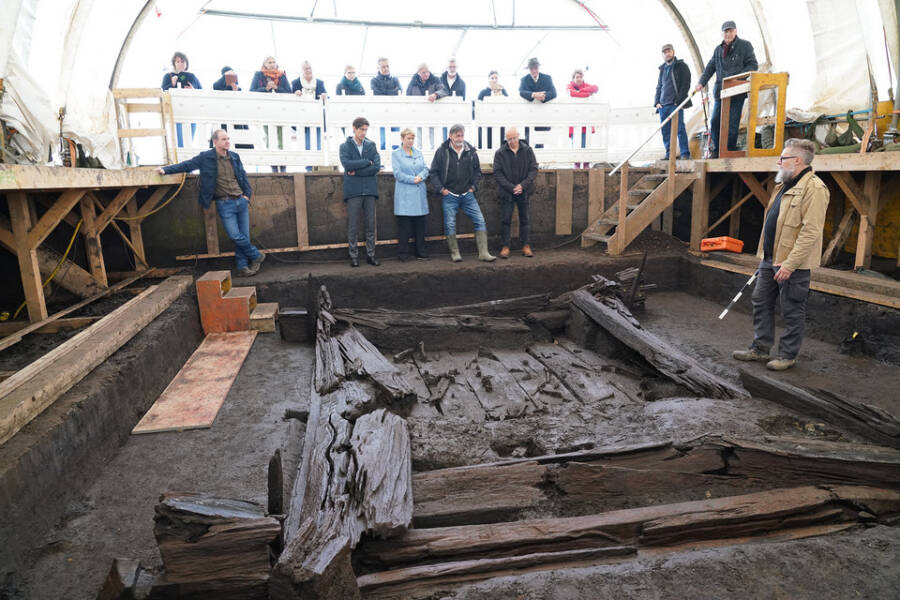Because Celtic burials like these were often extremely large, they tended to attract grave robbers almost immediately, meaning that archaeologists have rarely found them intact.

Andreas Dubslaff/State Office for Monument Preservation in the Stuttgart Regional CouncilResearchers stand next to the Celtic burial chamber near the town of Riedlingen in southwestern Germany.
Between 620 B.C. and 450 B.C., the Celtic peoples of southwestern Germany built “princely burial mounds” to commemorate high-ranking individuals. Archaeologists recently uncovered one of these mounds near Riedlingen that dates back to the 6th century B.C.E. The find is especially rare due to the remarkably well-preserved oak wood chamber at its center.
Furthermore, artifacts such as ceramic vessels, human remains, and evidence of a chariot were discovered in the burial mound as well. However, researchers found evidence of looting and believe that grave robbers may have removed valuable items from the site soon after it was established.
Despite the looting, the discovery is considered highly significant due to the preservation of the burial chamber, which is rarely seen in this region. Ongoing excavations and further analysis will hopefully provide more insights into who was buried at the site and the burial practices of the time, contributing to the history of Celtic culture in Europe.
Archaeologists Discover An Ancient Celtic Burial Mound In Southwestern Germany

Quentin Sueur/State Office for Monument Preservation in the Stuttgart Regional CouncilAn aerial view of the Celtic burial excavation site near Riedlingen, Germany.
Located only four miles north of Heuneburg, the oldest urban settlement north of the Alps, the site near Riedlingen holds a lot of promise for researchers. The Stuttgart Regional Council began excavations of the nearby area last year in hopes of discovering more about its ancient history.
During their excavations, archaeologists uncovered a large Celtic burial mound, measuring roughly 213 feet in diameter. To their shock, the team also discovered a solid oak wood burial chamber in the center of the mound measuring 11 feet by 13 feet.

Jörn Heimann/State Office for Monument Preservation in the Stuttgart Regional CouncilThe exposed oak ceiling of the burial chamber.
This find was exceptionally rare, as most wood artifacts often degrade within a few years. Since the Celts of central Europe primarily built with wood, it is exceedingly difficult to uncover structures from this time period.
Only one Celtic burial chamber made of wood had ever been discovered in Germany before now. In 1890, an excavation of an area in the Black Forest uncovered a wooden burial chamber, but poor preservation techniques and documentation led to its degradation — making this recent find all the more important.
“The Riedlingen grave is a stroke of luck for archaeology: the scientific significance of this fully preserved Celtic chamber grave, investigated using modern methods, extends far beyond the boundaries of Baden-Württemberg and southern Germany,” Dirk Krausse, an archaeologist with the State Office for Cultural Heritage Baden-Württemberg, stated in a press release.
As researchers continue their work, they’ve already gained intriguing insights. A club-like wooden artifact discovered at the site, for instance, has been dated to the 6th century B.C.E., providing valuable information about the construction methods used for the burial mound and its contents.
Pottery, A Crystal Amulet, And Other Artifacts Are Unearthed Within The Burial Chamber

Faber Courti-al/State Office for Monument Preservation in the Stuttgart Regional CouncilA rendering of the Celtic burial mound, including the location of the central burial chamber.
During the excavation, archaeologists uncovered a small pit in the mound that contained ceramic vessels holding human remains that date back to 600 B.C.E.
Preliminary analysis suggests that the burial chamber housed a young male, likely between 15 and 20 years old, but further testing is required to confirm his identity. Meanwhile, remains discovered in the mound belong to an adult male, estimated to be between 25 and 35 years old, who was likely interred around 500 B.C.E.

Quentin Sueur/State Office for Monument Preservation in the Stuttgart Regional CouncilThe skeleton of a Celtic man from the 6th century B.C.E. that was discovered at the site.
However, the site had long ago been disturbed by looting that now complicates the researchers’ work. A small hole, likely created by grave robbers, was discovered in the southeast corner of the chamber — suggesting that valuable artifacts may have been stolen at some point during antiquity.
While no metal objects have been found in the chamber itself, remnants of bronze and iron nails were uncovered, hinting that a four-wheeled chariot may have once been part of the burial. Chariots were common features in elite Celtic burials, often indicating the high status of the buried individual.

Faber Courti-al/State Office for Monument Preservation in the Stuttgart Regional CouncilA rendering of the burial mound that depicts the grave robbers’ tunnel.
Excavations at the site are expected to continue over the next few weeks, with researchers working meticulously to preserve and document their findings.
As Dr. Roberto Tarpini of the State Office for Cultural Heritage Baden-Württemberg noted, “The investigations and analyses that will be carried out after the excavations are completed will lead to further important findings, particularly on the question of who this monumental burial mound was built for.”
After reading about this Celtic burial, dive into the story of Morrígan, the Celtic goddess of fate, war, and death. Then, read about Samhain, the Celtic harvest ritual and festival of the dead.





